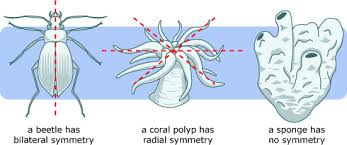Characteristics of Animals
- Eukaryotic
- Multicellular
- Heterotrophic
- Can move at some point in their life cycle
- No cell walls
Animal Diversity
Animals can be subdivided into invertebrates (those without a backbone) and vertebrates (those with a backbone). 96% of all animals are invertebrates. We will investigate some of the more representative phyla of invertebrates before looking at the phylum Chordata (the vertebrates).
Phyla:
Evolutionary Trends in Animals
Symmetry
- Some animals lack symmetry (are asymmetrical)
- Some animal have radial symmetry meaning you can cut animal in several directions and get equal pieces that are roughly the same.
- Some animals have bilateral symmetry meaning you can only make one cut to get two pieces that look roughly the same.
Bilateral symmetry evolved due to the evolution of a head in animals. Many invertebrates have simple heads with small, simple brains. The head is a region where sense organs (noses, eyes, ears) begin to develop giving the animal a different perspective of the world around them. Animals that have radial symmetry have some awareness all around them; they do not experience “front” or “back”, “left” or “right”. For organisms with radial symmetry all sides are equal. Animals with a head begin to experience the world in terms of “forward” (like traveling head first) and “backwards” (traveling tail end first). This directionallity changes the way they experience the world and the way they react to the world around them.
Movement
Animals have evolved several different mechanisms of movement. Some animals, like sponges are sessile as adults. The larvae are small and swim through the aquatic environment using flagellated cells. Some animals use undulation, the back and forth movements of specific muscle type, to move through water. Flatworms on land use a combination of cilia and slime to aid their movement. Segmented worms thrash back and forth to move. These worms are also able to scrunch their bodies, then force their heads (or tails) forward into the soil to move. They use hair like seta to anchor their bodies as they scrunch again in preparation for another forward thrust.
Some of the more successful phyla to have invaded the terrestrial realms are those that have jointed limbs. Arthropods such as millipedes, centipedes, isopods, and insects have become dominant on land. These organisms are located nearly world wide and are well adapted to a variety of habitats, partially due to their original ability to move well on land.
Tetrapods are a group of vertebrates that have also adapted to land. These animals have well developed limbs with internal bones to support their weight. The limbs of tetrapods have diverged (adapted in different ways to different environments) and are now very diverse.
